Photos: SHTF: Prepping: How To Preserve Your Whole Harvest For Winter Without Refrigeration
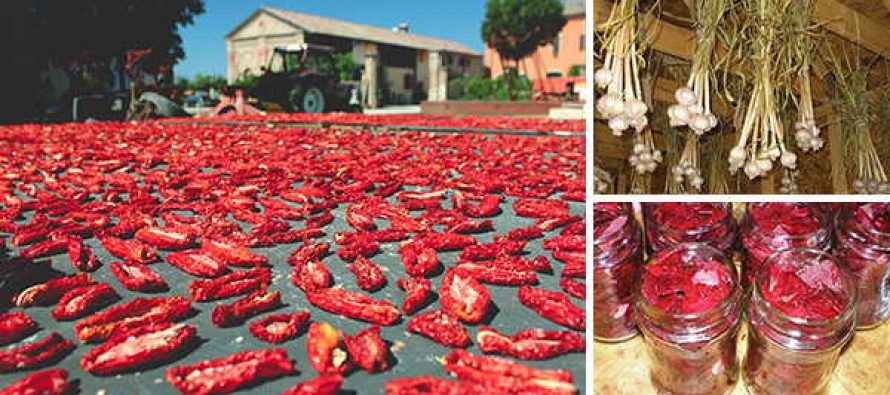
Knowing how to preserve your harvest even without refrigeration is an important way to deal with surpluses and avoid waste, as well as to see you through months when your garden isn’t as plentiful.
The first step to successful longer-term preservation is understanding what makes produce spoil in the first place. When it comes to food storage, your biggest enemies are:
- Some foods begin to dry out when exposed to oxygen for prolonged periods. You may notice changes such as lettuce becoming limp and wilted, oranges shrinking and hardening, or the skin of cucumbers starting to wrinkle.
- Humidity is often a good thing when it comes to fruits and veggies, but too much moisture can lead to quicker rotting. That’s why, for example, greens stay fresh so much longer when stored with paper towels between the leaves.
- Ethylene gas. A natural plant hormone, ethylene gas speeds up ripening when exposed to oxygen and carbon dioxide. Some veggies and fruits release this gas as they age. The release of ethylene gas affect other nearby produce, so foods that produce ethylene should be kept away from foods that are sensitive to it.
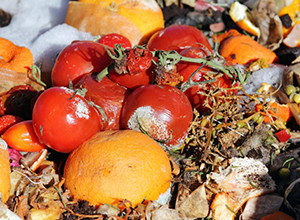 Produce tends to be rich in natural enzymes that provide essential health benefits for our bodies. These enzymes become active when the food is cut or peeled. They are also sensitive to heat and will cause the food to spoil quickly once cut.
Produce tends to be rich in natural enzymes that provide essential health benefits for our bodies. These enzymes become active when the food is cut or peeled. They are also sensitive to heat and will cause the food to spoil quickly once cut.- Other chemical changes. Oxygen, sun exposure, and high temperatures all work together to escalate the spoilage of your produce. In general, store your food away from heat and sunlight, and eat any pieces with natural cuts or bruises first.
Do keep in mind that any mishandled produce may contain unsafe microorganisms that can cause illness if ingested. Any pathogens in your fresh food can quickly multiply at room temperature, make your food spoil faster, and potentially spread to other foods nearby. Do not eat anything that you suspect may be contaminated or rotten.
With this information in mind, let’s look at the best ways to preserve your whole harvest with no refrigeration.
Related: Sealed Foods that Last Forever
Storing
Some of your fruits and vegetable will store well for months under the right conditions.
For best results, choose unblemished items and check them regularly for signs of spoilage – it’s true that “one rotten apple can spoil the whole bunch.” Here are some tips for storing different items.
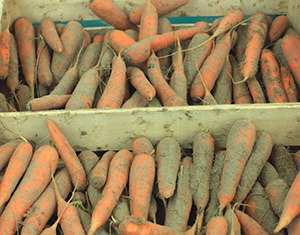 Root Vegetables
Root Vegetables
Potatoes, carrots, and beets are well-suited to storing.
Remove the leafy tops from carrots and beets and place them in a single layer without wrapping. A layer of sand can keep both from becoming rubbery.
For potatoes, harvest them on a dry day and leave them out in the sun to dry completely. Remove any mud and store in paper sacks in the dark.
Parsnips are a root vegetable exception: leave them in the ground over winter and harvest as needed.
Apples and Pears
These fruits will also store very well. Wrap each fruit in newspaper and store in a single layer.
Garlic, Onions, and Shallots
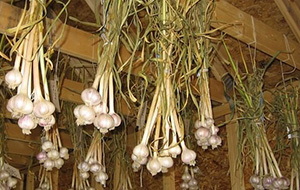 Dry these veggies thoroughly and then braid before storing in a dry place.
Dry these veggies thoroughly and then braid before storing in a dry place.
Alternatively, you can cut off the tops and fill a net or an old pair of stockings with the bulbs.
Hang these to keep them dry, preferably in a breezy location.
Related: Homemade Fermented Honey Garlic
Items in The Squash Family
Pumpkin, butternut, and spaghetti squash, for example, can last for several months, depending on the type.
Pumpkins won’t likely last past midwinter, but other squashes may keep well through early spring. Choose specimens in good condition and store them in a cool, dry place. Zucchini does not store well, unfortunately.
Beans and Peas
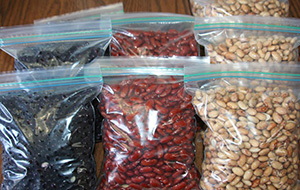 You can dry beans and peas for long-term storage.
You can dry beans and peas for long-term storage.
There are different methods for drying beans at home – one method is to simply leave the pods on the plant until they are dry and hard and will break and spill the seeds out (but be sure to harvest before they break on their own).
Keep dried beans around to use in soups, stews, or as meals all on their own.
Leafy Greens
Leafy crops, such as spinach and lettuce, do not store well long-term. However, you can continue sowing these plants into early autumn so that there will still be fresh leaves to harvest after the weather turns colder.
Drying
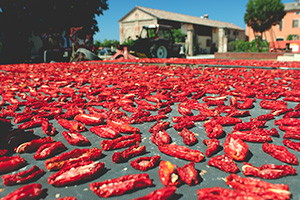 You can dry some foods to produce interesting new flavors and textures to add to your dishes when you cook.
You can dry some foods to produce interesting new flavors and textures to add to your dishes when you cook.
Tomatoes, apples, and peppers all dry well. Drying produce is easy; simply slice the food thinly and arrange in a single layer on a tray. You can then use the traditional method, which involves leaving your trays outside over long, sunny days.
Alternatively, you can use a quicker and easier process: set the trays in your oven on its lowest setting (250F) for a few hours or until the food has shrunk and become almost crispy. Then, store the dried pieces in sterile, airtight containers and use them within several weeks.
Pickling and Canning
Beets and shallots taste delicious when pickled and will last for months.
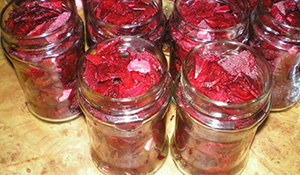 Beets
Beets
Wash and prepare your beets but avoid removing the tops too close to the root, as this may allow the color to leach out.
Boil for half an hour or until the tops and skin rub off easily. Slice the beets, place in sterile jars, and cover in pickling vinegar.
Shallots
Peel and trim the bottoms and tops. Let sit overnight in a shallow dish filled with salt to draw out excess moisture. The next day, rinse the shallots thoroughly, place in sterile jars, and cover with pickling vinegar.
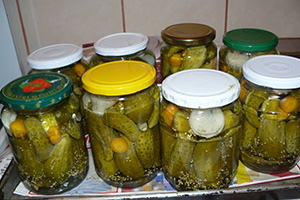
Good news for zucchini lovers: you may not be able to store them dry for very long, but you can make chutney with them, as well as more or less any excess from your garden, such as tomatoes, plums, garlic, mint, onions, cherries, and much more.
Related: Canning Meatloaf for Meals in a Jar
You may also can a wide variety of vegetables and fruits for later use, including cucumbers, tomatoes, beans, corn, most fruits, squash, leafy greens, asparagus, carrots, and more.
If you own chickens or cows, you may also bottle stock.
You worked hard on the food you grew; a little know-how can help you keep it fresh and healthy well into the winter months. Congratulations on your great harvest!

